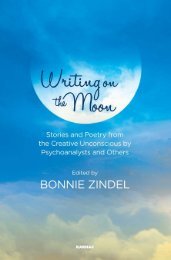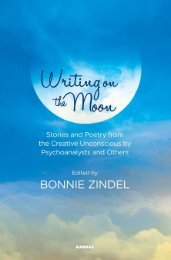0000000000000
Create successful ePaper yourself
Turn your PDF publications into a flip-book with our unique Google optimized e-Paper software.
xviii<br />
INTRODUCTION<br />
response was overwhelming. Hundreds of poems poured in from as<br />
far away as Australia, South Africa, England, France, Scotland, Israel,<br />
Canada, New Zealand, and across the United States.<br />
Suddenly, I was faced with a dilemma: how to select the eight or ten<br />
poems that I had space to publish. What criteria would I use? I am not<br />
a literary scholar. I have no training in critical theory. I am a psychoanalyst<br />
and a writer. I have spent the better part of my life studying the<br />
craft of writing, and I write creatively almost every day. Thinking about<br />
the creative process is a passion, and I have found, at last, that I can<br />
serve two masters: psychoanalysis and writing. And I love them both.<br />
How did my psychoanalytic sensitivity affect what I responded to? I<br />
decided to trust my creative intuition. Did I respond emotionally to the<br />
poem? Was I moved? Did it feel original? Did I want to read it again?<br />
Did the writers allow me into their being? The feedback on the third<br />
issue was very encouraging. Psychotherapists told me how meaningful<br />
it was to have this place to bring another part of themselves. And readers<br />
told me how much they enjoyed the themes and selections. I realized<br />
I was onto something, and in the years ahead, I put out many other<br />
calls that stimulated the imagination: “Dreams as poetry,” “Love calls—<br />
a call for love,” “Strong women’s voices.” In the call for “Mothers of<br />
the Milky Way” I said, “Mothers come in complex ways. Surprise us.”<br />
You will see the fruits of these calls throughout the book. Two-thirds<br />
of the contributors are psychoanalysts and psychotherapists. The other<br />
twenty-nine contributors are patients, artists, poets, writers, performers,<br />
professors, and cartoonists.<br />
The ideas for the calls came from my creative unconscious and leapt<br />
into the red-hot embers that animated the creative unconscious of many<br />
others. The Notes from the Creative Literary Editor that I began to write for<br />
each issue are also unconscious collaborations. This is what Shakespeare<br />
called “epiphenomenology,” where one person’s idea sparks another<br />
and another—like shooting stars. When these sparks happen, the ideas<br />
are combustible. The outpouring of submissions and the quality of the<br />
work have been extraordinary. I am thrilled to preserve some of the best<br />
of these shooting stars in Writing on the Moon.<br />
Bonnie Zindel<br />
www.bonniezindel.com







